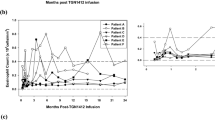Summary
Three pilot studies testing thymopentin in AIDS patients are presented. One study included 5 patients with the full-blown syndrome, all treated with 50 mg thymopentin 3 times a week by intravenous slow infusion; no immunologically nor clinically positive results were observed, indicating that the T cell pool in such patients is severely depleted. Six other patients with the prodromal stage of AIDS were treated 1 month with 50 mg thymopentin administered as an intravenous bolus injection 3 times weekly and thereafter for another month with same dose regimen as intravenous slow infusions. The patients on infusion therapy experienced statistically significant immunological improvements; these positive findings were paralleled with an improvement of the patients’ clinical condition. These positive responses persisted for an average of 8 months. In another group of 5 pre-AIDS patients thymopentin was administered via the subcutaneous route using 15 mg 3 times weekly; only 1 patient revealed immunological and clinical improvement. In summary, only patients with the pre-AIDS syndrome are likely to benefit from immunomodulation therapy with thymopentin, and the mode of administration seems to be crucial.
Résumé
Trois études pilotes sur le traitement de cas de SIDA par la thymopentine sont présentées ici. Le premier volet englobait 5 patients porteurs du syndrome déclaré, tous traités à raison de trois perfusions intraveineuses lentes de 50 mg de thymopentine 3 fois par semaine; on n’a observé aucun résultat immunologique ou clinique positif, ce qui montre la déplétion grave de la réserve de cellules T existant chez ces patients. Six autres patients au stade prodromique du SIDA ont été traités pendant 1 mois à raison de 3 injections par semaine d’un bolus de 50 mg de thymopentine, puis 1 mois selon le même schéma posologique mais en perfusions intraveineuses lentes. Quatre patients ont présenté des améliorations immunologiques statistiquement significatives qui étaient plus nettes après le traitement par perfusion; ces résultats positifs étaient accompagnés d’une amélioration de l’état clinique. Ces réactions positives ont persisté pendant 8 mois. Dans un autre groupe de patients «pré-SIDA», on a utilisé 3 injections par semaine de 15 mg de thymopentine par voie sous-cutanée; un patient seulement a bénéficié d’une amélioration immunologique et clinique. En résumé, seuls les patients au stade prodromique du SIDA sont susceptibles de bénéficier d’un traitement immunomodulateur par la thymopentine. De plus, le mode d’administration semble d’une importance cruciale.
Zusammenfassung
Es werden drei Pilot-Studien mit Thymopentin bei Patienten mit AIDS vorgestellt. Der vorliegende erste Teil umfasst 5 Patienten mit voll ausgebildetem Syndrom; alle 5 wurden mit 50 mg Thymopentin dreimal wöchentlich in Form einer langsamen intravenösen Infusion behandelt. Es wurden weder klinisch noch immunologisch positive Resultate gesehen, was darauf hindeutet, dass in solchen Patienten der Vorrat an T-Zellen weitgehend erschöpft ist. Sechs andere Patienten in der prodromalen Phase von AIDS wurden 1 Monat lang mit 50 mg Thymopentin als intravenösen Bolus dreimal wöchentlich behandelt; danach wurden sie einen weiteren Monat lang mit derselben Dosis als langsame intravenöse Injektion im gleichen Regime behandelt. Nach der Infusionstherapie kam es zu einer statistisch signifikanten Besserung der immunologischen Befunde, die von einer Besserung im klinischen Befinden der Patienten begleitet war. Die positiven Reaktionen hielten 8 Monate lang an. In einer weiteren Gruppe von Patienten im prodromalen Stadium von AIDS wurde Thymopentin in einer Dosis von 15 mg subkutan dreimal pro Woche verabreicht; nur bei einem Patienten trat immunologische und klinische Besserung ein. Zusammenfassend kann gesagt werden, dass wahrscheinlich nur Patienten im prodromalen Stadium des AIDS-Syndroms von der immunomodulatorischen Behandlung mit Thymopentin profitieren. Ferner scheint die Anwendungsweise des Medikaments von ausschlaggebender Bedeutung zu sein.
Riassunto
Il presente lavoro tratta di tre studi di base sulla terapia con thymopentine in casi di pazienti affetti da SIDA. Il primo gruppo comprendeva 5 pazienti con sindrome dichiarata, tutti trattati con tre perfusioni i.v. con somministrazione lenta di 50 mg di thymopentine tre volte alla settimana; non fu costatato alcun risultato immunologico o clinico positivo, ciò che mostra la grave diminuzione della riserva di cellule T presenti in questi pazienti. Altri 6 pazienti ehe si trovavano allo stato prodromico del SIDA vennero trattati durante 1 mese con una terapia iniziale consistente in tre iniezioni per settimana di 50 mg di thymopentine, in seguito durante 1 mese secondo il medesimo schema di posologia, ma sotto forma di perfusione i.v. lenta. Quattro pazienti hanno presentato dei miglioramenti immunologici statisticamente significativi più netti dopo la terapia per perfusione; questi risultati positivi erano pure accompagnati da un miglioramento del quadro clinico. Queste reazioni positive hanno avuto una durata di 8 mesi. In un altro gruppo di pazienti ‘pre-SIDA’ vennero fatte tre iniezioni di 15 mg di thymopentine alia settimana per via sottocutanea; solo 1 paziente mostrò un miglioramento immunologico e clinico. Riassumendo, solo i pazienti ehe si trovano allo stato prodromico del SIDA sono suscettibili di beneficiare d’un trattamento immunomodulatore dopo somministrazione di thymopentine. In particolare, il modo di somministrazione del farmaco sembra avere un’importanza primordiale.
Resumen
Se presentan tres estudios piloto en los que se ensaya la timopentina en pacientes afectos del SIDA. Esta primera parte comprende 5 pacientes con el sindrome desarrollado, tratados todos ellos con timopentina 50 mg, 3 veces a la semana por infusion i.v. lenta; no se observó ningún resultado positivo immunológico ni clínico, lo cual indica que el pool de células T en dichos pacientes está seriamente disminuido. Otros 6 pacientes con la fase inicial del SIDA fueron tratados durante 1 mes con timopentina 50 mg en forma de inyección i.v. en bolo, 3 veces semanales y luego durante otro mes con el mismo régimen posológico en forma de infusiones i.v. lentas. Cuatro pacientes experimentaron mejorías inmunológicas estadísticamente significativas que fueron más impresionantes tras el tratamiento por infusión, estos hallazgos positivos se acompañaron de una mejoría del estado clínico de los pacientes. Estas respuestas positivas persistieron durante 8 meses. En otro grupo de 5 pacientes pre-SIDA se administró timopentina por vía s.c. a razón de 15 mg, 3 veces a la semana; sólo un paciente manifestó una mejoría inmunológica y clínica. En resumen, sólo pacientes con el síndrome pre-SIDA pueden beneficiarse de un tratamiento de inmunomodulaciôn con timopentina. Ademàs, el modo de administración parece ser crucial.
Similar content being viewed by others
References
Fauci, A.S.: The acquired immune deficiency syndrome; the ever broadening clinical spectrum. J. Am. med. Ass.249: 2375–2376 (1983).
Dardenne, M.; Bach, J.F.; Safai, B.: Low serum thymic hormone levels in patients with acquired immunodeficiency syndrome. New Engl. J. Med.309: 48–49 (1983).
Clumeck, N.; Sonnet, J.; Taelman, H.; Mascart-Lemone, F.; De Bruyère, M.; Van de Perre, P.; Dasnoy, J.; Marcelis, L.; Lamy, M.; Jonas, C.; Eyckmans, L.; Noel, H.; Vanhaeverbeek, M.; Butzler, J.P.: Acquired immunodeficiency syndrome in African patients. New Engl. J. Med.310: 492–497 (1984).
Goldstein, G.; Scheid, M.P.; Boyse, E.A.; Schlesiner, D.H.; Van Wauwe, J.A.: Synthetic pentapeptide with biological activity characteristic of the thymic hormone thymopoietin. Science204: 1309–1310 (1979).
Mascant-Lemone, F.; Delespesse, G.; Servais, G.; Kunstler, M.: Characterization of immunoregulatory T lymphocytes during aging by monoclonal antibodies. Clin. exp. Immunol.48: 148–154 (1982).
Audhya, T.; Goldstein, G.: Comparative efficacy of various routes of administration of thymopentin (TP-5) with consideration of degradative mechanisms. Int. J. Peptide Protein Res.22: 187–193 (1983).
Audhya, T.; Goldstein, G.: Thymopentin (TP-5) potency in vivo is enhanced by slow infusion. Int. J. Peptide Protein Res.22: 568–572 (1983).
Author information
Authors and Affiliations
Rights and permissions
About this article
Cite this article
Clumeck, N., Cran, S., Van de Perre, P. et al. Thymopentin treatment in aids and pre-aids patients. Surv. immunol. Res. 4 (Suppl 1), 58–62 (1985). https://doi.org/10.1007/BF02919057
Issue Date:
DOI: https://doi.org/10.1007/BF02919057




